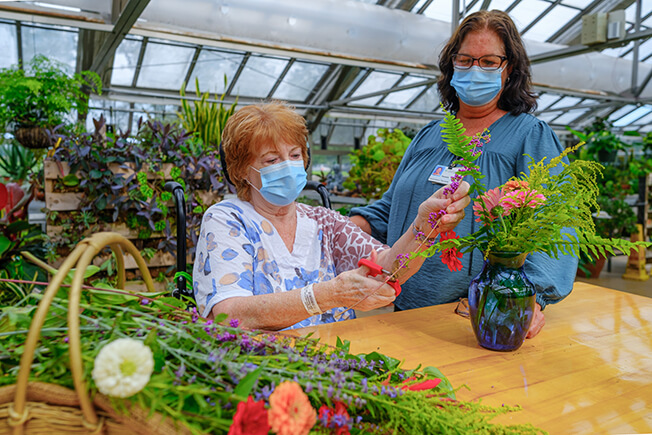Horticultural therapy offers benefits for physical rehab patients

When enrolling in a physical rehabilitation program, many patients already know what to expect. Rehabbing after a joint replacement? You'll be spending plenty of time in physical therapy. Recovering from a brain injury? Your days might involve a mix of occupational, physical and speech therapy. Very few patients might expect to be spending time in a greenhouse. But the benefits of horticultural therapy can be exponential for patients with a variety of needs.
"Horticultural therapy is a change of pace from traditional therapies. Recovering from a serious injury can be physically and emotionally taxing, and horticultural therapy allows patients the opportunity to contribute to their recovery in a natural, calming environment," explains Pam Young, who oversees the Horticultural Therapy Program and Sydney Thayer III Horticultural Center at Bryn Mawr Rehabilitation Hospital.
Although patients may appreciate the unique environment of horticultural therapy and a "break" from the gym or therapy classroom, time spent in the garden or greenhouse isn't an interruption of a patient's treatment; it's a supplement to their treatment.
What does horticultural therapy involve?
Horticultural therapy allows patients to continue working on their rehabilitation goals in a one-on-one or group setting. By taking part in interactive activities like planting seeds and watering or repotting plants, patients improve their mobility, balance, endurance, memory, and social skills.
"Getting back to nature is key to a patient's recovery. Our horticultural therapists work with a patient's entire care team to define an individualized plan of care based on their age, health status, and ability," says Young. "In addition to being physically beneficial, many patients also say that horticultural therapy is spiritually and emotionally beneficial."
Not a gardener? Not a problem, says Young.
"Horticultural therapy doesn't require you to have a green thumb. Horticultural therapy encompasses a number of different activities. We find a role for every interested patient," she says.
Activities vary widely, from starting seeds and arranging and pressing dried flowers to outdoor activities, like growing vegetable plants. At Bryn Mawr Rehab, patients are also involved in donating harvest from the vegetable garden to local good banks and putting freshly blossomed flowers to use as centerpieces in the hospital dining room.
Who may benefit from horticultural therapy?
Although horticultural therapy has become a more popular program in recent years, it is not offered at all physical rehabilitation centers. Young, who has seen firsthand the benefits it offers her patients, urges individuals and families to do their research when choosing a rehab center.
The horticulture therapy program at Bryn Mawr Rehab benefits patients of all ages with a wide range of limitations, from those who may be managing a lifelong disability to those recovering from serious injury. A uniquely designed greenhouse with extra wide aisles and non-skid floors accommodates people in wheelchairs.
Adds Young, "Horticultural therapy offers patients the opportunity to address their therapy goals in a unique and special way. It provides a healing environment that our patients are drawn to and connect with, and it makes them feel productive because they're able to do something meaningful during their recovery, which can be a difficult time."
Main Line Health serves patients at hospitals and health centers throughout the western suburbs of Philadelphia. For acute inpatient rehabilitation, call 484.596.6000.
 Content you want, delivered to your inbox
Content you want, delivered to your inbox
Want to get the latest health and wellness articles delivered right to your inbox?
Subscribe to the Well Ahead Newsletter.
